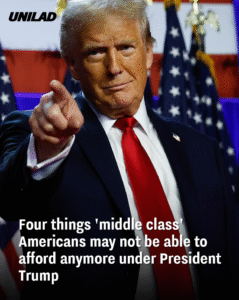Four Things ‘Middle Class’ Americans May Not Be Able to Afford Anymore Under President Trump
As former President Donald Trump leads a high-profile campaign for re-election, many middle-class Americans are wondering what another Trump presidency could mean for their wallets. While supporters champion his tax policies and deregulatory approach, critics warn that his economic plans may further strain a demographic already feeling squeezed.
Here are four key things that middle-class Americans may struggle to afford under Trump’s return to the White House, based on his policy proposals and past administration trends:
1. Health Care
During his first term, Trump made multiple attempts to repeal the Affordable Care Act (ACA), and he’s recently doubled down on those efforts, stating he wants to “replace Obamacare with something better.” However, a clear replacement plan has yet to be revealed. In the absence of a robust alternative, many fear that millions of Americans could lose access to affordable health insurance, especially those with pre-existing conditions.
Without the ACA’s subsidies and coverage protections, middle-class families who don’t qualify for Medicaid but can’t afford high private insurance premiums may find themselves stuck in a health care limbo. Out-of-pocket expenses, deductibles, and prescription drug costs could soar — putting basic health care out of reach for many.
2. Home Ownership
Trump’s economic philosophy includes deregulation of banking and financial sectors. While that may stimulate markets, critics argue it could open the door to predatory lending and unstable mortgage practices. Coupled with inflationary pressures and rising interest rates, the cost of buying a home could climb sharply.
Middle-class families—especially first-time buyers—may find it harder to qualify for affordable mortgages or compete in a market that favors wealthier investors. During his previous administration, homeownership rates among the middle class stagnated, and housing affordability became a nationwide concern. A similar trajectory could worsen under a second Trump term.
3. Higher Education
Trump has been vocal about cutting federal funding for higher education and reducing the government’s role in student loans. While he’s advocated for vocational education and alternatives to college, fewer supports for students mean families will bear more of the burden.
If federal student aid is slashed, tuition assistance shrinks, and loan forgiveness programs vanish, college could become a luxury only the upper class can afford. Middle-income students may be forced to take on more debt—or forego college entirely—reducing future economic mobility.
4. Child Care
One of the most overlooked financial burdens on middle-class families is child care. Under Trump, tax benefits for working families existed but fell short of addressing the true cost of quality child care. His proposed budgets often included cuts to programs like Head Start and the Child Care and Development Block Grant, which help working parents afford care.
Without government support or subsidies, middle-class families could face skyrocketing child care expenses—forcing one parent to stay home, cutting household income, or relying on substandard options.
While Trump remains a polarizing figure, his economic track record and proposed policies suggest that the cost of living for middle-class Americans may climb in key areas. Whether these concerns sway voters will likely depend on how they balance promises of economic growth against the practical costs of everyday life.
